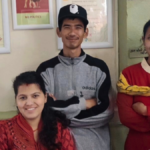
Our first month in Nepal
And just like that, our first month in Nepal is over.
We have visited numerous potential locations for the library and gained valuable insights into the lives, challenges, and needs of the respective communities.
We selected the potential locations based on the following criteria:
- No more than 4 hours by car from Pokhara
- Accessible by road
- Population between 3,000 and 7,000
- Existing community building available for use as a library
- Strong interest and engagement from the community
- The caste system does not hinder anyone from using the library
We would like to take you along and introduce you to a few of the places we visited:
Bhalam
We start the day with a delicious breakfast and then head to the headquarters of “Rights4children” in Pokhara.
There, we meet Anil, who works for the organization and will show us two potential locations for the library today. Together, we drive to the outskirts of Pokhara, navigating through the dense and noisy city traffic, and passing by impressive and untouched landscapes.
After a half-hour drive, we arrive at the charming village of ‘Bhalam’.

Our first stop is the ‘Agricultural Support Office,’ where we are welcomed with a traditional greeting ceremony. Present are, among others, the school principal, the head teacher, and the mayor.
The welcome ceremony involved draping a scarf, called a ‘Khada’, around our shoulders. This symbolizes purity and compassion. The Khada is also used in various ceremonies such as weddings, births, greetings, and farewells.


In addition, we receive a ‘Tika’, a red mark on our foreheads. The dye for this mark is usually made from dried turmeric. It is said to focus energy and enhance concentration.
After the ritual, we are allowed to tour the rooms designated for the project. A large room, currently used for conferences, could be converted into the main library. Next to it are two smaller, currently unused rooms. The wall between them could be removed to create another large space, which could serve as a computer room.


Next to it is a beautiful garden with a variety of plants. A significant portion of the community earns its livelihood through agriculture. To support the village’s business in distribution and sales, they have established an agricultural cooperative. The neighboring school also specializes in agriculture and teaches children about it from a young age.
At our request, the head teacher shows us the school library. We had the impression that the library was very disorganized and lacked a proper filing system, which, unfortunately, is common in many school libraries in Nepal.

Khoramukh
The Nepali NGO READ Nepal has already received several requests from this community for a community library and has been involved in their needs assessment. After a bumpy ride and the customary warm meeting and exchange with the community leaders, we, along with our two Nepali friends who are translating for us, set out to interview people of all ages, genders, and social groups about the project.


We found that many people were not exactly sure what a library is and what its purpose is. However, after explaining this in more detail, people showed great interest but expressed a desire for an e-library with computers and few physical books. They also mentioned that it would be difficult for mothers to visit the library since they usually have to take care of their young children.
The respondents and Sapana generally consider it an excellent idea to set up a children’s area in the library or in an additional room, with many children’s books and educational toys. The young mother was particularly pleased with this suggestion, as it would enable her to visit the library with her children.
The proposed building is very large, with two floors. They plan to use one of the floors as a conference room.




Bhurungkole
During our visit to ‘Bhurungkole’, we were once again warmly welcomed with a greeting ceremony in front of the mayor’s house and were also served a cup of sweet tea.
During the discussion, we learned that the community is currently working on improving the local water supply. However, the room proposed for the project is very small, and we quickly concluded that it is not large enough for our ideas. The terrace with its beautiful view of the fields and houses, though, was a highlight.
We ended the day feeling satisfied, with many new impressions of the villages and their people.


Conclusion
We have visited spaces that could potentially serve as locations for the library. Now, we will delve deeper into the various communities to ensure that people are genuinely interested and willing to commit long-term. Without their full engagement, the sustainability of the library cannot be guaranteed. We will take the necessary time to get to know the communities and then select the most suitable location.




